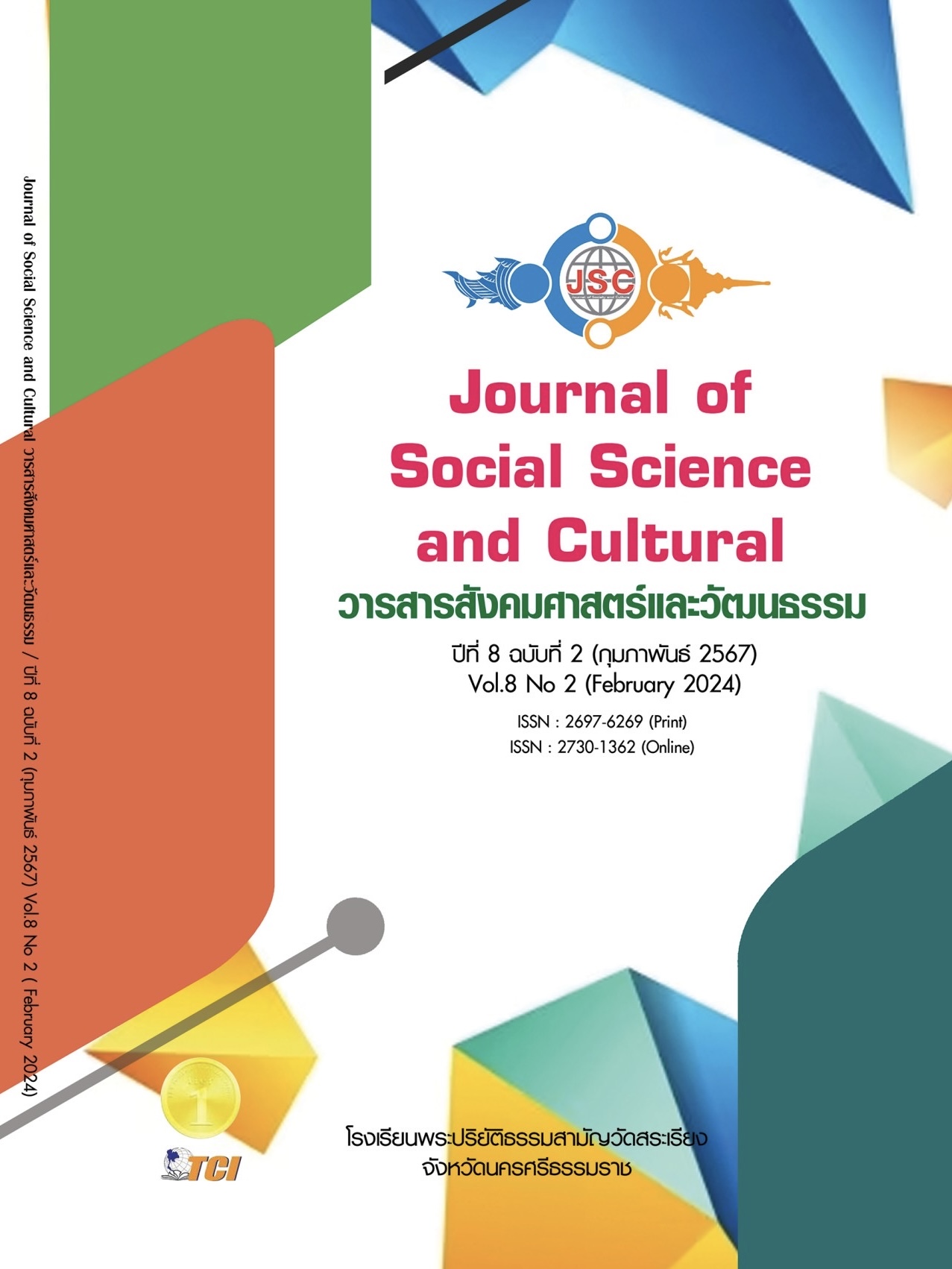INTEGRATION OF THAI ART ACTIVITIES TO PROMOTE THE CULTURE OF PEACE MODEL
Main Article Content
Abstract
The objectives of this research were to: 1) Study the characteristics of the social and cultural conditions and the elements that cause conflict; 2) Study the elements or foundations of Thai art and apply them to the organization the process of relational art and Development of Thai art integration activities to promote a culture of peace. The population for this research was a purposive sampling of 35 experts in seven fields: peace studies, art education, contemporary artists, Thai art, event organizing, traditional activities, and community leaders. The communities in Bangkok were selected based on their multiculturality, art, culture, and traditions that integrate Thai art wisdom. This research and development study used qualitative methods in two phases:
- Data Collection and Contextual Analysis; Expert interviews and community observation. The research tools used were: 1) In-depth interviews; 2) Observation of data and the general condition of the community. The data was analyzed using data clustering and content analysis. 2. Activity Model Development; The results of the research found that: Development of integration of Thai art activities to promote the culture of peace focuses on four objectives: 1) understanding and trust, 2) love and respect, 3) non-violence, and 4) participation and cooperation. This is the application of the principles of Thai art wisdom using relational aesthetics, which is an aesthetic experience in a contemporary art based on shared elements or foundations in Thai art that have the same common point, and the 7 elements of activity theory that are in line with the community's way of life to the event activities. There are three main thematic activities: 1) Local food of the community: Showcasing local food with historical significance and integrating the way of life through collaborative efforts. 2) History of the community: Using local history to link relationships through activities for practical use and development. 3) Sense of community: Engaging in activities based on shared interests and common use, fostering interdependence and close relationships to build sustainable peace culture.
Article Details
References
ชัยวัฒน์ สถาอานันท์. (2558). Nonviolence: สันติวิธี เส้นทางสู่สันติภาพ. กรุงเทพมหานคร: คณะเศรษฐศาสตร์ มหาวิทยาลัยธรรมศาสตร์.
มติชนออนไลน์. (2562). ม.1 ขโมยปืนพ่อยิงเพื่อนดับ แค้นโดนแกล้ง-ล้อเป็นตุ๊ด. เรียกใช้เมื่อ 18 ธันวาคม 2562 จาก https://www.matichon.co.th/news-monitor/news_1823199
ศุภการ สิริไพศาล และอดิศร ศักดิ์สูง. (2552). การดําเนินนโยบายสังคมพหุวัฒนธรรมในรัฐเคดาห์และปีนัง ของมาเลเซีย ค.ศ. 1970 - 2008. กรุงเทพมหานคร: สํานักงานกองทุนสนับสนุนการวิจัย.
ศูนย์สร้างสรรค์งานออกแบบ. (2561). eBook เจาะเทรนด์โลก 2018. เรียกใช้เมื่อ 13 พฤศจิกายน 2562 จาก https://web.tcdc.or.th/th/Publication /Detail
สถาบันทักษิณคดีศึกษา มหาวิทยาลัยศรีนครินทรวิโรฒ. (2559). วัฒนธรรมภาคใต้. ใน สารานุกรมวัฒนธรรม พ.ศ. 2529. กรุงเทพมหานคร: อมรินทร์การพิมพ์.
สำนักข่าวเดลินิวส์. (2561ก). เขตบางคอแหลมส่งหนังสือสั่งมัสยิดห้ามเสียงดัง. เรียกใช้เมื่อ 5 ตุลาคม 2561 จาก https://www.dailynews.co.th/regional/669745
สำนักข่าวเดลินิวส์. (2561ข). เมื่อวัดไทรเสียงระฆังก้อง ดังไปไกลในอินเทอร์เน็ต. เรียกใช้เมื่อ 11 ตุลาคม 2561 จาก https://www.dailynews.co.th/article/670609
Barkhordari, M. et al. (2016). The Importance of Art-Based Curriculum in Peace Education. Review of European Studies, 8(4), 220-231.
Bourriaud, N. (2002). Relational Aesthetics. Printed in lespressesdureel: France.
Cengelci Kose, T. & Gurdogan Bayir, O. (2016). Perception of peace in students’ drawings. Eurasian Journal of Educational Research, 65(2016), 181-198.
Chang, R. (2005). Culture and art education in China Education through Art. International Journal of, 1(3), 225-236.
Fabricio, F. (2013). Peace Profile: Vicent Martínez Guzmán. Peace Review: A Journal of Social Justice, 25(3), 439-446.
Issifu, A. K. (2016). Local Peace Committees in Africa: The Unseen Role in Conflict Resolution and Peacebuilding. The Journal of Pan African Studies, 9(1), 141-158.
Vygotsky, L. S. (1978). Mind in society: The development of higher psychological processes. Massachusetts: Harvard University Press.
Wasson, R. et al. (1990). Teaching Art in the Multicultural Classroom: Six Position Statements. Studies in Art Education, 31(4), 234-246.
Xanthaki, A. et al. (2022). Culture 2030 Goal campaign. Retrieved November 13, 2019, from https://culture2030goal.net/.


